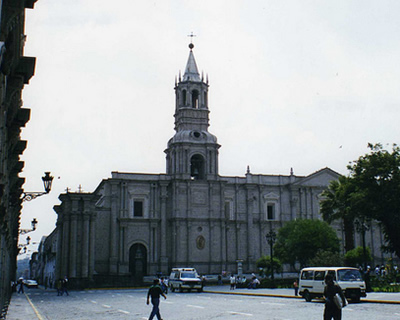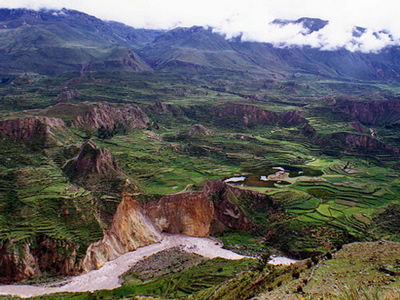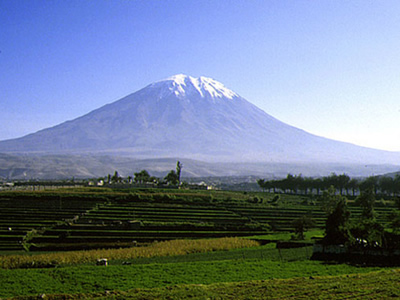The name comes from the Quechua Arequipa Ari-quepay, «Yes, stay», words which, according to legend, the Incan Emperor gave permission to his soldiers to establish a colony on the site.
Photography by wallygrom
The «white city», so named because its historic buildings are built with volcanic stones, a very white stone, is the capital of southern Peru. Its colonial buildings sparkling in the upper valley of the River Chili, are dominated by the perfect cone, threatening at times, the volcano Misti.
The department of Arequipa has an area of 63.528km2 and is situated between southern Peru, between the Pacific Ocean and the continental watershed, represented by the peaks of the Cordillera Occidental. It limits the north with the departments of Ica, Ayacucho, Apurimac and Cuzco. To the east with Puno and Moquegua, and south and west by the Pacific Ocean.
Arequipa: Peru’s southern capital:
After the Inca emperor gave permission to his soldiers to settle in Arequipa, in 1540 the city was conquered by the Spanish. They renamed it the name of Our Lady of the Assumption of Valle Hermoso.
It is a strategic passage between the mountains and the coast. The city, situated at 2,300 m altitude in a volcanic valley arid climate, but watered by the river Chili grew quickly becoming the natural capital of the southern region of Peru.
Between 1836 and 1839, the creation of the Peruvian-Bolivian Confederation, was inaugurated as South Peru’s capital. It was one of the three republics that comprised the transient state.
Arequipa was a prominent conservative stronghold and it came numerous rebellions and pronouncements in the nineteenth century and first half of XX.
Archiepiscopal and university:
Arequipa is the capital of the department and province of that name, archiepiscopal and university. It is linked to Lake Titicaca and Cuzco by the roads that traverse the valley. It is served by the Southern Railway and a branch of the Pan American Highway. It has, also a major airport, shopping, textiles, leather, food (milk and beer).
Its streets paved with cobblestones, the main square and web, we fall back to bygone times too, which is complemented by a visit to the convent of Santa Catalina, a true monument of the city, built in 1580 and persists today in perfect architectural conditions.
Volcanic stones:
Arequipa’s historic buildings are built with volcanic stones, lightweight and very white. Are characteristic thick walls and vaults equipped with heavy buttresses to prevent the effects of earthquakes are very common in southern Peru. The facades of the buildings are made with hard work and beauty.
The Convent of Santa Catalina, is itself a small monastic town. The seventeenth-century cathedral (it has been rebuilt), the church and cloister of the Society of Jesus, located off the main square, all the chapels and colonial houses of the square of San Francisco and various patriarchal churches and houses, as the Goyeneche and Ricketts Irriberry are all the eighteenth century.
The University of San Agustin has a fine collection of pre-Columbian ceramics and mummies.
Three major regions:
The lands of the Peruvian department of Arequipa rise from the parched shores of the Pacific to the eternal snows of the volcanoes of the Western Cordillera of the Andes.
Both physically and in the human and economic development can be distinguished in the territory three major regions: the coast, narrow strip of arid and temperate. It is characterized by low-altitude desert landscape and a half; the plain, which is an area between one thousand and three thousand feet, where rainfall is low and seasonal, and the mountains, where the plateau extends from cold and dry climate, is the area in which rise the snowy peaks of the Andes.
Rivers and volcanic cones:
Rivers Acari, Yauca, Ocoña, Majes, Sihuas, Vitor and Tambo, who descend to the Pacific, are short and torrential. Their feeding channels of scarce water and snow in the mountains, carving deep canyons and fertilizing in irrigated areas and coastal plain.
Also an abundance of high-altitude volcanic cones, three of which, Misti, Nevado Chachani and Picchu Picchu overlooking the valley where the capital is located.
The area is sparsely populated department and most of its inhabitants are concentrated in the capital in fact.
Photography by wallygrom
Agriculture:
This is irrigated, and focuses mainly on the coast and in the Vitor River basin, regulated by the reservoir of El Fraile. It is grown industrially, cotton, sugar cane and rice. There is also a Mediterranean plantations as vines, olives and beef cattle are raised, llamas and alpacas. Industry, mainly food, wool and leather goods are in the capital, Arequipa, while the processed fish is in Mollendo. In Acari has deposits of iron.
The Southern Railway crosses the department communicating ports of Mollendo and Matarani, located on the Pacific, through the valley of Arequipa, Puno port on Lake Titicaca and Cuzco.
The area is rich in agriculture, animal breeding and harness work. Tourism is growing every day, leaving visitors ecstatic contemplation of its wonderful stonework buildings in well preserved, the convent of Santa Catalina, his place with the portals of the sixteenth century, its beautiful cobbled streets and friendly people. Arequipa, the «white city» of Peru is an unforgettable place where you always try to return. The most important thing is that the city looks like 400 years ago, a rare find today. So remember his name in Quechua-quepay ari, «Yes, stay» as a success. It is a city where you really want to stay and settle.
Photography by Xtremizta
Enjoy your trip!
Leave a Reply
You must be logged in to post a comment.



Recent Comments